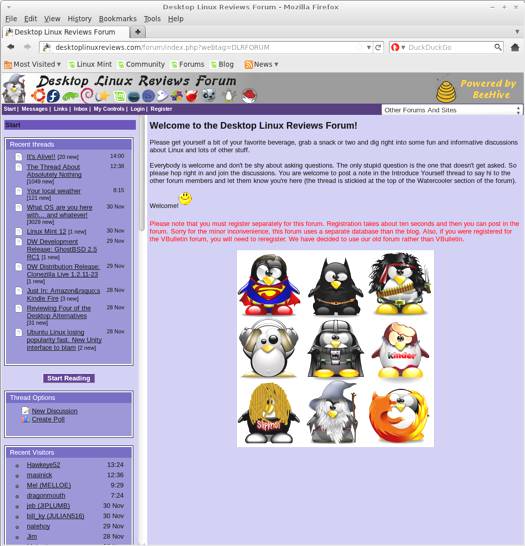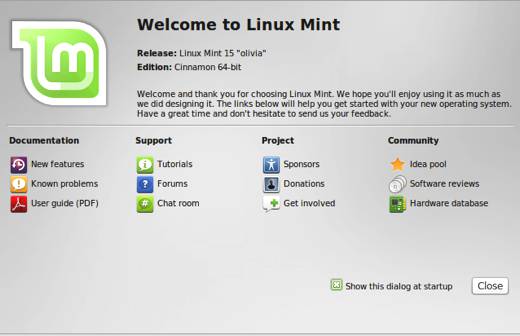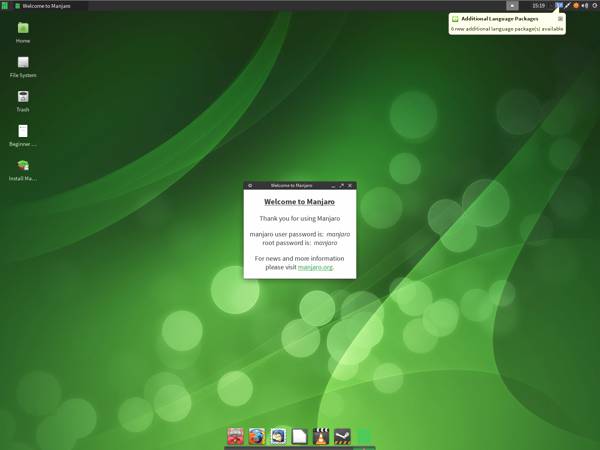Siduction 11.1 is a fork of the Aptosid distro. Siduction comes in KDE, Xfce or LXDe spins. You can get 32-bit or 64-bit versions of each spin. Siduction is based on Debian Sid and includes Linux Kernel 3.1-6 and X.Org server 1.11.2.902.
For this review I opted for the Xfce version.
Some of you might wonder why there was a need to fork Aptosid in the first place. The developers of Siduction posted an explanation for why they decided to do it. I’ll just let you read it in full and make up your own mind, as I prefer to focus on the features of a distro rather than the intrigue related to its creation or demise.
From Knoppix to sidux
Anyone who has been lingering around in the orbit of Sid-based Distros for some time, will know the history from Knoppix over KANOTIX to sidux and aptosid.
There isn’t much to say against aptosid (on the technical side of things), it’s solid, released on a regular basis, maintained responsibly. In two words: it works. What hindered aptosid from having the success that sidux promised it would have is firstly the discourse with users, which implies that a community is not really wanted and rather cumbersome. Evolving from this latent feeling was a group of users deemed as renitent, which have been consequently expelled due to their criticism. Finally I as well had to realize, that despite it’s technical brillance, which up to that point still kept me in their ranks, there was no future there for me.
From sidux to aptosidMany among those users who now participate in this new reboot hadn’t taken the step from sidux to aptosid anymore. At that time, I hadn’t lost all hope yet and have tried to give a platform to the German users, that wasn’t restricted by, from my point of view, absurd and excessive censorship and would instead favor respect and free speech. As long as this forum exists, this concept proved to be unproblematic. What was to be expected, as aptosid.com is the only forum I know of, incapacitating and expelling it’s users in such a rigid way.
From aptosid to a friendly OS
The things stated above don’t fully legitimate a fork in my opinion, and our ideas don’t end here. But we are convinced, that a distribution should first of all live by involving it’s users. After all the give & take is a basic principle of free (and open) software. This principle is also valid for the upstream direction. We should give back as much as possible to Debian. At aptosid, my efforts to get closer to Debian have always been eyed suspiciously. Whenever practical results were possible, there was retreat. For example ceni is still not in Debian, despite some lively interest. There was also never an infrastructure to ease bug tracking and triage, to work towards Debian. This shall now change.
The aptosid artwork got worse and more inconsistent in recent releases, a concept is not perceivable anymore. The attempts to create a Corporate Design at sidux failed due to the departure of two members of the art team. aptosid design has a recognition value by now, but rather for bad design.
We will not force our own preferences on our future users with kernel options, package selection and pre-configurations, like for example with aptosids K-menu defaults. Wherever it seems wise, the community shall co-decide. We will always prefer free software and drivers, but in no way prevent nonfree variants. It’s important for the user to know, what free and proprietary means in this context. From there on, he/she has to decide on his/her own.
We are siduction, your friendly aptosid fork 2011 :)
So there you go, those are the reasons why Siduction was created.
Before I get into the review, let me do a bit of blog housekeeping. I’ve changed the format of the reviews. I removed the separate install and multimedia pages, and I’ve gotten rid of the screenshot section for booting and login. I’ve also added system requirements to the what’s new page.
This has shortened the number of pages of each review and eliminated some of the unnecessary screenshot production I was doing for each review. The multimedia section was redundant since that software is listed already on the software page, and I doubt many readers really want to see a step by step of each install.
For me this makes it much easier to focus on the new features and lifts the burden of having to do tedious and probably unnecessary screenshots for each review. For the readers it eliminates some fluff from the reviews while also shortening the number of pages for each review.
I hope you like the changes. Now on to the rest of this review.
What’s New
Since this is a first release, there really isn’t a list of what’s new. So I’ll just list the system requirements and then move right into the Desktop & Software section.
System Requirements
Here’s what you’ll need to run this distro:
AMD64
CPU requirements:
- AMD64
- Intel Core2
- Intel Atom 330
- any x86-64/ EM64T capable CPU or newer
- newer 64 bit capable AMD Sempron and Intel Pentium 4 CPUs (watch for the “lm” flag in /proc/cpuinfo or use inxi -v2).
RAM requirements:
VGA graphics card capable of at least 640×480 pixel resolution.
- KDE: ?512 MByte RAM (?1 GByte RAM recommended), ?1 GByte RAM for liveapt.)
- XFCE: ?512 MByte RAM.
- LXDE: ?512 MByte RAM.
- Optical disk drive or USB media.
- ?3 GByte HDD space, ?10+ GByte recommended.
i686
CPU requirements:
- Intel Pentium pro/ Pentium II
- AMD K7 Athlon (not K5/ K6)
- Intel Atom N-270/ 230
- VIA C3-2 (Nehemiah, not C3 Samuel or Ezra)/ C7
- any x86-64/ EM64T capable CPU or newer
- the full i686 command set is required.
RAM requirements:
VGA graphics card capable of at least 640×480 pixel resolution.
- KDE: ?512 MByte RAM (?1 GByte RAM recommended), ?1 GByte RAM for liveapt.
- XFCE: ?512 MByte RAM.
- LXDE: ?512 MByte RAM.
- Optical disk drive or USB media.
- ?3 GByte HDD space, ?10+ GByte recommended.
The Desktop
As I noted earlier, I opted for the Xfce version of Siduction 11.1.
When you first load Siduction’s desktop you’ll see the “one step beyond” wallpaper with some dice and the Siduction logo and slogan. Blue and orange aren’t my favorite color combination, but your mileage may vary. There are some very attractive wallpapers included though so just right-click your desktop and choose Desktop Settings. I thought the squirrel wallpaper was very cute.
You’ll also note the following icons on the desktop:
Home
File System?Trash
Bluewater Manual
Siduction IRC
I wasn’t sure what the Bluewater Manual referred to so I clicked it and then a web page loaded in Iceweasel. Apparently, it’s the Siduction manual. So bear that in mind if you decide to try Siduction. Once the web page loads you’ll need to choose your language and then you can start reading the manual.
To access application categories, help, log out, etc. you just need to click the Xfce button at the far left of the top panel. Everything is laid out as you’d expect, and it’s quite easy to navigate around to open applications, use accessories, or do some system management.
At the bottom of the desktop is a panel that contains a number of icons for system management and various applications.
Here’s a list:
Terminal Emulator
File Manager
Web Browser
Application Finder
Minitube
AbiWord
DeadBeef Music
XChat IRC
Brasero
Gnumeric
Xarchiver
Orage Calendar
There’s quite a bit of the functionality that most people would need if they used Siduction on a daily basis. You can easily edit the bottom panel by clicking on the Xfce menu button in the top panel, selecting Settings then Panel, and then go to Panel 2. Click the Items tab after the Panel 2 menu loads to add or remove items to the bottom panel. You can also right click on the items in the panel for a faster way to remove, add items, etc.
Bundled Software
Here’s a sample of the software included in this release.
Games
No Games Included
Graphics
Document Viewer
Image Viewer
Ristretto Image Viewer
XSane Image Scanning Program
Internet
Ceni
Elinks Web Browser
Iceweasel
XChat IRC
Multimedia
Brasero
DeaDBeeF
Minitube
Mixer
Pragha
Xfburn
Office
AbiWord
Gnumeric
Orage Calendar
Orage Globaltime
Software Management
Siduction comes with a useful, but limited amount of software. Most of the necessary application functionality is covered, but you might not like the choices presented for applications.
There is no GUI software management tool included with Siduction. So you will need to add Synaptic yourself via the terminal. I’ll have more to say about this in the problems section of the review.
Next, I’ll share some of the problems I encountered, show you where to get help, and I’ll share my final thoughts.
Problems & Headaches
Siduction wasn’t the speediest distro for me. It seemed a bit slow at times when I was loading applications. This surprised me since I was using Xfce, which is usually quite speedy about such things.
The installer may also be a bit daunting to Linux newbies. I had no problem with it, but I’ve been installing distros for years. There were certain parts of the install that could confuse some of the newer folks. I’d like to see a simplified install process that is similar to some of the more newbie-friendly distros like Ubuntu.
I was also surprised to see that LibreOffice didn’t come installed. AbiWord and Gnumeric are okay, but I suspect many users would like to be able to use a more comprehensive office suite.
This leads me to what is probably the biggest problem with Siduction. There is no GUI software management tool included with it. I was surprised that Synaptic wasn’t installed by default at the very least. You can install it via the command line yourself.
But, given that Siduction is supposed to be a desktop distro, I expected some sort of GUI based software management tool. Yes, there are folks who prefer the command line. There is nothing wrong with that and more power to them.
There are other folks, however, who have come to expect some sort of basic GUI software management tool to be included. Maybe they have been spoiled by Linux Mint or Ubuntu, but such is the time we are living in. The days of the dominance by command line software management are over.
Or maybe I’ve just gotten lazy? I’d be curious to read your thoughts about this in the comments section. Should we expect all desktop Linux distros to offer a GUI based software management tool? Or should people be left to fend for themselves at the command line? These questions and your answers could be good column fodder.
Synaptic itself, while very powerful, is not the most attractive software management tool these days. Still, it does provide software management tools in a GUI package so adding it might be a good idea in a future release.
Where To Get Help
Please take a moment to register for the DLR forum; everybody is welcome. Feel free to post a message in the forum and we’ll do our best to point you in the right direction. The forum contains discussions about Linux, as well as other topics. Please stop by and say hello when you have a chance.

You might also want to check out the Siduction forum, blog, and bug tracker pages. You can also use IRC channels #siduction for English support, and there is the option of #siduction-core.
Final Thoughts & Who Should Use It
I think it’s still early for Siduction. It seems off to a good start, but it could use some more polish to catch up with other desktop distros. The installer and the software management issues might turn off some potential Siduction users.
It will be interesting to see how many of the Aptosid users move over to Siduction. One of the nicest things about Linux is that there really is a distro for everybody. So Aptosid users that feel the same as the Siduction developers can jump ship and move on.
Siduction is definitely best suited for intermediate or advanced Linux users. Beginners will probably find the lack of a GUI software management tool to be a deal breaker. I suggest one of the buntus or Linux Mint if you’re new to Linux.
What’s your take on this distro? Tell me in the comments below. Visit Eye On Linux for Linux opinion columns and distro quick looks; visit JimLynch.com for other technology coverage.
Summary Table:
| Product: | Siduction 11.1 |
| Web Site: | http://siduction.org |
| Price: | Free |
| Pros: | Fork of Aptosid; comes in KDE, LXDE or Xfce spins. |
| Cons: | No GUI software manager; installer could be more intuitive and slicker. |
| Suitable For: | Intermediate and advanced Linux users. |
| Rating: | 3.5/5 |











